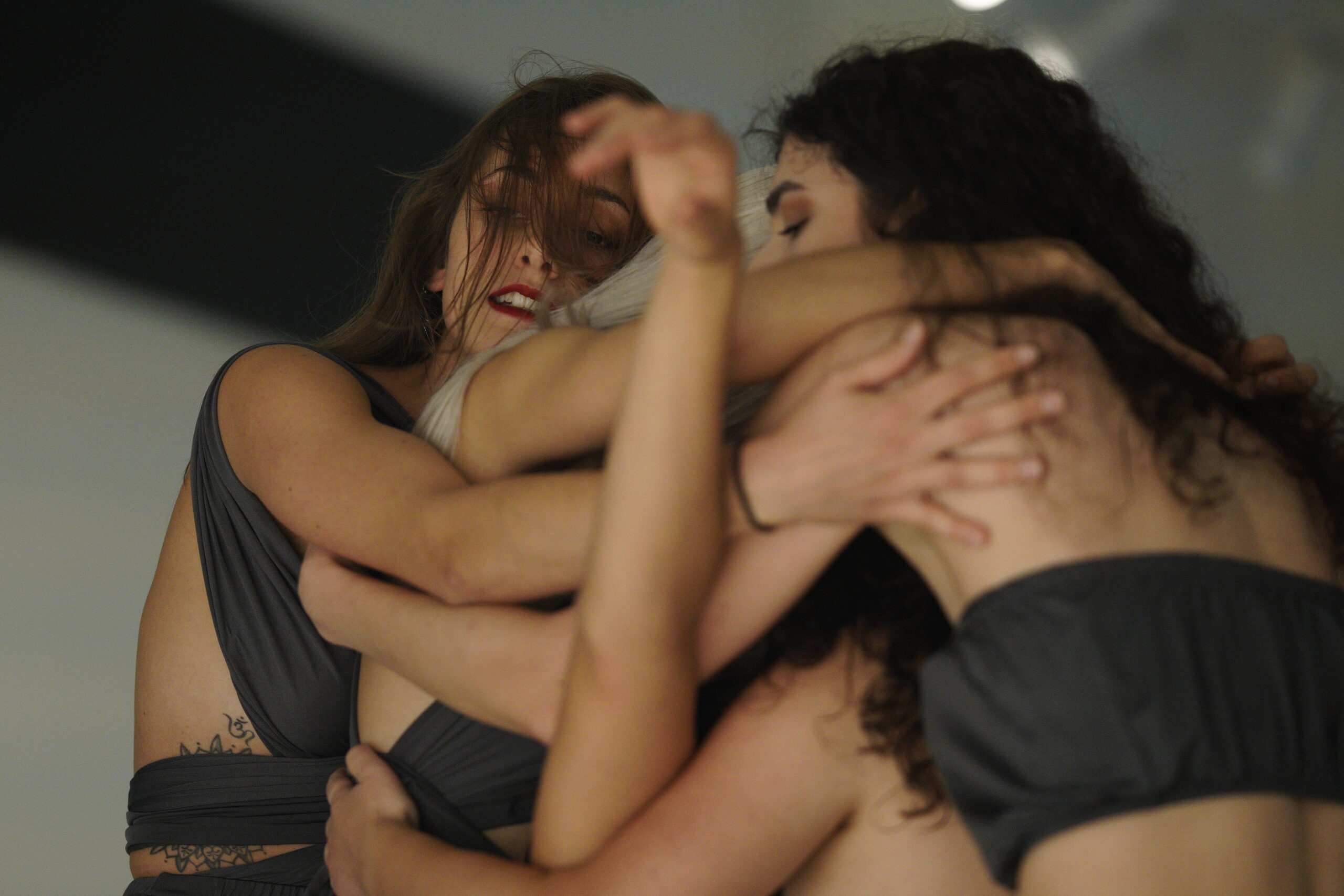This is Me Eating, performed by Et Alia Theater, was uncommonly elegant. The soft gray gowns worn by the women of the company had the flow of classical statuary, and the grace of the wearers recalled the Living Pictures of the 19th century, the Attitudes of Lady Hamilton, Lily Bart in The House of Mirth, and the dances of Isadora Duncan. In the theater, some costumes merely fit. These draped, creating new pictures with each gesture, stride, or pose, continuous and shifting.
Yet This is Me Eating tackled a visceral reality, the fraught and animalistic need to eat, its aesthetic elegance in counterpoint to its theme. In Anna Karenina, someone says over a lavish dinner that the purpose of civilization is to make all things, including the necessity of eating, pleasurable. Et Alia may or may not embrace that notion, but this dramatization of eating in tension with civility, body image, and ethics made a work of beauty and fascination.
There is no judgment in the art of Et Alia—none on the spot, at least. The ethical dimension of eating was acknowledged, whether relating to environment, animal welfare, world hunger, or body image, but also to responsibilities had to ourselves, to wants and pleasures not to be dismissed. And to ways of life, to which food rituals are fundamental (little is more offensive than the tourist who disapproves the diets of foreign cultures). This is Me Eating answered yes or no to none of the moral questions; it asserted their urgency but didn’t berate or prescribe.
It was staged at Alchemical Studios as an audience immersion by women from four cultures—Brazilian, Italian, Romanian, Turkish—who have worked, lived, and made art in many more. Deniz Bulat, Luísa Gallati, Ana Moioli, Maria Müller, Giorgia Valenti (who conceived the piece), and Debora Balardini (the director) invited the audience to stand or sit where they chose and to interact with the performers. They—we—held back the night I attended; unless I missed it, no one jumped in without being prodded. Bulat ate forlornly at a table set for multiple diners, from an empty plate; I nearly joined her, but did not bring myself to, civility dictating that one waits to be asked. Some audience responded to specific prods, including entering an interlocked sculpture with Valenti, out of which she departed and returned as they held position.
The initial images teased the theme: a dangling apple (food—the first temptation), an inflatable tub filled with popcorn (which Moioli would bathe in, gleefully), Valenti (the Italian) expertly twirling spaghetti onto a fork in successive bites. There were pedestals and mirrors; abstract, environmental music filling the space. A dance emerged, gestures of supplication and praise alternating with postures of defiance, odd torques and distortions, some suggestive of food put into mouths or resistance to it, and the grooming of body, face, and hair.
Stories were told, games played, questions asked, food (but ironically little) consumed, including by the audience, who were tossed chocolate kisses. There was a game like Twister with flavors as the points of contact, acts of self-admiration and body anxiety, fitness routines, and a digital scale. Holding a great blue exercise ball, Gallati wondered if the Earth itself exists to be consumed, its purpose and ours in turn.
The images were intercultural, the words multilingual, sometimes translated and sometimes not, but always meaningful. Müller translated Romanian expressions referring to weight; “parentheses” for “thigh gap” stood out. The personal was shared but never in a self-centered way—“this is not about me,” someone said. There wasn’t a shred of narcissism; if anything, it was critiqued. These are likable performers, as well as talented and skilled ones, and with an intense performative intelligence.
This is Me Eating grew out of an online project in which the members of Et Alia and others contributed videos of themselves, well, eating during the pandemic lockdown. The quality and import varied, but the result was compelling. Isolation makes the necessary apparent, as boredom does the reality of routine. Each video communicated an immediate reality, such as the loss of taste and smell due to Covid. A video collage of this precursor project came near the end of the live version, linking isolation to community, infection to health, virtuality with embodiment, each highlighting the other.
The subject of food and theatrical performance is capacious, ranging from the interrupted suppers of Macbeth, Titus Andronicus, or Don Giovanni; to the conviviality of films like Big Night or Babette’s Feast; the generational symbolism of Wilder’s The Long Christmas Dinner; Belasco’s recreation of Childs Restaurant in The Governor’s Lady; dinner theater and the pre-show prix fixe; the problem of eating on stage when there are lines to be said; and the scandal of waste when real food or drink are trashed.
The suggestive staging of This is Me Eating raised those associations and more. There was an ethics to the production as well as an art. With astounding simplicity (eating is just eating, weighing yourself just stepping on a scale, grooming just looking in a mirror), its images reverberated with familiarity but made you look again, and think.
Et Alia Theater’s This is Me Eating was performed in 2021. The company’s next live show will be White Rabbit Red Rabbit, by the Iranian playwright Nassim Soleimanpour, on March 13 at Theater of the New City in New York. Click here for information and tickets.
